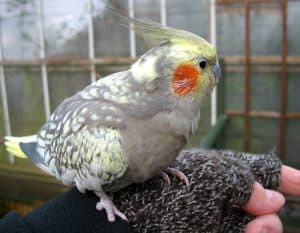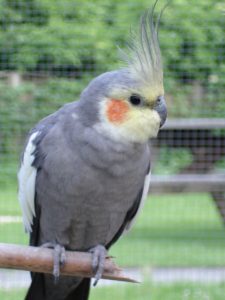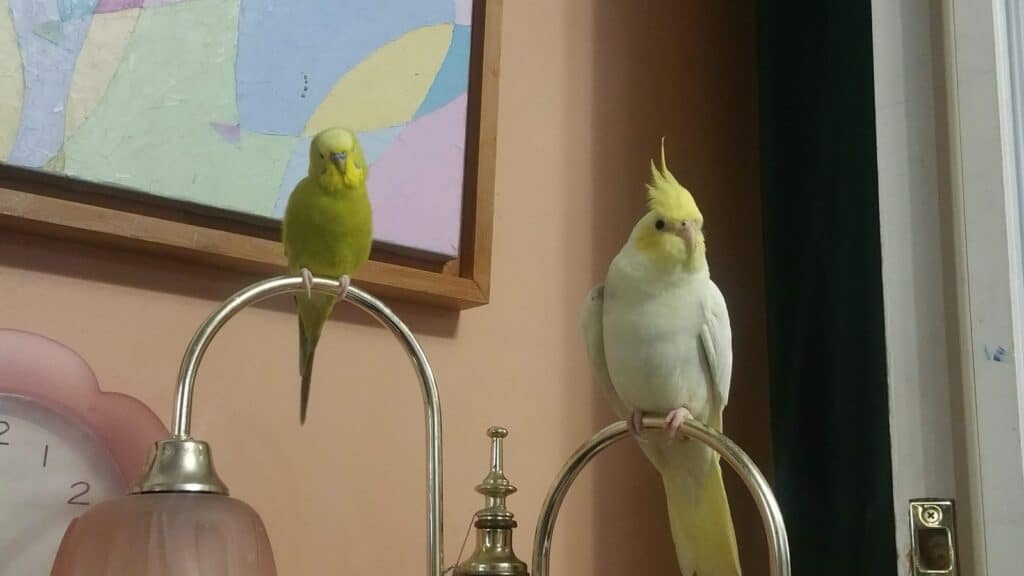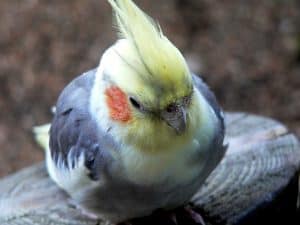Wondering how do you tame a cockatiel? It’s important to understand the background of your pet birds, including its age and previous residence, in order to advance cockatiel taming skills. As a result, understanding the previous family’s connection and living condition is critical in order to avoid bringing problems with you.
Young pet bird can be difficult to train because they have a distinct personality that needs to be tamed and socialized. It might take time to successfully tame a cockatiel with prior bad experiences and inadequate socialization.
If you want to teach your cockatiel basic tricks, it’s a good idea to begin with solitary sessions and quiet locations. Young birds are faster to train than adult bird, so this is more useful if you’re teaching them as chicks. To learn about the many phases involved in taming a cockatiel, read everything below about training sessions so you can begin taming.
Can You Actually Tame a Cockatiel?
Yes, you can tame a cockatiel. Cockatiels are social birds and can form strong bonds with their human caregivers. Taming a cockatiel requires patience, consistency, and gentle handling. The process can take several weeks or even months, depending on the bird’s personality and past experiences.
To tame a cockatiel, start by creating a calm environment and offering the bird treats to establish trust. Talk to the bird in a soft and soothing voice, and offer your hand slowly and gently once the bird is comfortable with your presence. Gradually increase the duration of your interactions and repeat the process daily.
Remember that every bird is unique and may require different methods of taming. Some birds may take longer than others to tame, but with patience and consistency, you can form a strong bond with your cockatiel.
Cockatiel Taming Tips
The bird’s cage might be set up and prepared in a variety of ways. One of the most important steps before bringing your bird home is to get it set up correctly and ready to go. In order for your own birds to feel safe, placing the cage with one side against the wall is essential. To prevent your cockatiel from being frightened by external elements such as hawks, dogs, and storms, place your cockatiel cage in front of the window.
When playing, a large cage is required for this sort of bird since to accommodate all their tail feathers and head crest. A big bird cage makes the bird at ease. Use untreated paper layers or towels with fine grating to get the cockatiel out of the bottom. Every day, peel away the layers to keep the cage clean and free of fungal spores and droppings.
Stay Unobtrusive And Quiet Near A New Cockatiel
It takes time for cockatiels to get used to their new cages and pet owners, especially if they have lived in solitary confinement. It is critical not to frighten them with abrupt changes around the cage. Avoid human interaction, standing over the cage, making loud noises, and doing anything else that may make the bird uncomfortable or scared.
Cockatiels should not be handled until at least a week after shipping, and preferably not the first day. Because it allows them more time to become used to all new sights, smells, and sounds, this is extremely important. You should make careful, deliberate gestures while feeding and cleaning the cage during the entire time you’re speaking with the bird, gently assuring it of its invulnerability.
Habituation
The scientific method utilized by researchers while researching wild birds is known as habituation. It entails spending more time near the cockatiel, allowing them to become accustomed to the owner’s presence without suffering any negative events. It’s crucial to spend at least twenty minutes each day sitting in front of the cage, speaking softly to the bird.
You should avoid giving your cockatiel anything to drink while you’re watching television or reading. Not only will it make them nervous, but it also makes them relaxed and calm. At this stage, you should try to maintain a calm and peaceful atmosphere for your bird rather than positive reinforcements through voice, head-scratching, and food threats. When you determine that your presence is not disturbing the birds, go to the next stage.

Food treatment
The process of taming begins when you begin to handle the bird more closely. It entails putting some millet on your hand and waiting for the cockatiel to pluck confidence before feeding it through the bars. It may take time to accomplish the task, but desire will eventually overpower fear and hesitation.
Open the cage door and stick your hand into the millet while delivering cockatiel spray. At this time, do not feed the bird through bars; instead, allow it to come close to you and receive spray millet straight from your hand. Furthermore, after the third day, you may offer your bird with greens through the cage bars. You should not make any abrupt movements away from it when it specks since you will quickly discover that you are harmless.
Finger training
Another taming step is to teach the cockatiel to perch on your finger or index finger and leave it there until the bird feels comfortable. When it’s comfortable and uses the finger as a perch after each nudge against its stomach, keep your finger where it is and gently stroke your new bird.
While on your finger, move the cockatiel about inside the cage. It may jump and get back to the cage perch but continue working on the finger training.
Take the cockatiel out of its cage
If you want to remove the bird from its cage, it will only work if the cockatiel becomes accustomed to your finger as a perch. However, because birds are hesitant to climb on your finger, this step may be tough. At this point, teach your cockatiel the step-up bird walk command by applying slight pressure on its chest with your finger, prompting it to place claws on your hand.
- STURDY CONSTRUCTION - Made of the highest-quality iron frame with a black powder varnish guaranteed to make this birdcage sturdy and durable, even against playful birds; With 4 caster wheels at the bottom, so you can move it anywhere you like, saving you effort
- MULTIPLE DOORWAYS - Designed with 2 doorways for your pet birds to enter and exit; The top of the cage opens up and can be propped open with a wooden crossbeam for your birds to stand on; Traditional doors are located on the side of the cage
- SLIDE-OUT TRAY - Equipped with a plastic tray at the bottom of this bird cage that can be removed for easy cleaning, so as to keep a clean and tidy environment as well as keep your pets safe
- VARIOUS WAYS TO PLAY - Includes a swing and multiple bars to stand on; Convenient doors so you can change the food without disturbing your pets; Locking joints to keep the cage secure; With little design features that stand out among the crowd
- EXTRA STORAGE SPACE - Comes with an additional mesh shelf so you can store food and toys out of the way; Provided with a wealth of accessories, including 4 Wooded perches, 4 Feeding cups, and 1 swing
Do not punish a cockatiel
When your untamed cockatiel attacks you, say no to command it to stop biting. It’s crucial to note that biting is a defensive strategy employed by birds in response to any alarming event detected. When cornered, birds are motivated to flee instead of fighting. Their natural inclination is to take flight when confronted with danger; this behavior has evolved over time and become more refined.
There are no physical methods for taming or re-taming birds that bite, but it requires time and effort. This is due to the fact that one technique may not work on another bird. If you want to avoid your cockatiel from biting, it’s important to discover what motivates him to bite and read his body language. To encourage appropriate conduct, offer rewards, accolades, and snacks. Biting may be frightening, and your bird may react instinctively by flapping its wings or withdrawing from your grip. This can make your parrot lose balance.
How to Tame a Scared Cockatiel?
Taming a scared cockatiel requires few weeks of patience, consistency, and gentle handling. Here are some steps bird owners can take:
- Create a calm environment: Start by placing the bird’s cage in a quiet and low-traffic area of your home. This will help the bird feel more secure and less threatened.
- Approach the bird slowly and calmly: When you approach the bird, do it slowly and calmly. Don’t make any sudden movements or loud noises that could startle the bird.
- Offer treats: Cockatiels love treats like millet, so offer a few pieces to the bird to establish trust and encourage it to associate you with positive experiences.
- Talk to the bird: Talk to the bird in a soft and soothing voice. This will help the bird get used to your presence and voice.
- Offer your hand: Once the bird is comfortable with your presence, offer your hand slowly and gently. Let the bird come to you on its own terms.
- Start with short sessions: At first, keep the sessions short and gradually increase the duration as the bird becomes more comfortable with you.
- Repeat the process: Be consistent with your approach and repeat the process daily. Over time, the bird will learn to trust you and become more comfortable around you.
Remember that every bird is different, and some may take longer to tame than others. It’s important to be patient and gentle with the bird throughout the process. If the bird seems too frightened or stressed, give it some space and try again later. Eventually, your tame cockatiels will be fun to play with.





I like this website it’s a master piece!
Glad I detected this ohttps://69v.topn google.Money from blog